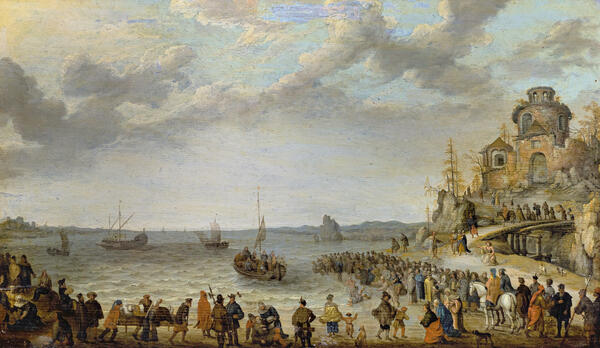The painting ‘People on the Seashore’ by Dutch artist Adam Willaerts is signed with the initials AW and the year 1635. It focuses on the late period of the Eighty Years’ War, or the Dutch War of Independence.
In the mid-16th century, the territories of the present-day Netherlands were under the control of Spain and the Holy Roman Empire. In 1549, King Charles V of Spain removed the region called the Seventeen Provinces from the Holy Roman Empire and made it the hereditary domain of the Austrian House of Habsburg. In 1555, he abdicated in favor of his son Philip II.
In 1566, there was a crop failure in the Seventeen Provinces, and taxes were raised again. This, as well as the harsh suppression of protest, mass executions and confiscations, persecution of the gaining Protestants, and centralization of power, led to a revolt. After a long guerrilla war and a series of rebellions, the United Provinces proclaimed themselves a republic in 1581. The rebellion turned into a war that lasted until 1609 and, after a 12-year hiatus, continued from 1621 to 1648.
The Dutch Republic grew and strengthened during the war, and the 17th century saw its maximum economic and cultural prosperity. The freedom and tolerance proclaimed in the country attracted many people from all over Europe, and famous writers and scientists came to teach and research at Leiden University. This period also witnessed the golden age of Dutch painting.
The Flemish landscape and marine painter Adam Willaerts was born in London in 1577. His parents were originally from Flanders and fled Antwerp for religious reasons when the Spanish came to power. By 1585, the family had moved to Leiden, and in 1597, Adam left for Utrecht. In 1611, he joined the Guild of Saint Luke, a trade association of painters, sculptors, and printers. In Utrecht, Willaerts lived and worked until his death in 1664.
Willaerts painted rivers and canals, rural, coastal and marine landscapes, fish markets, and genre scenes. He also loved naval warfares, for example, his painting “Allegory of the Dutch Defeat of the Spanish Fleet in Gibraltar” is housed by the Rijksmuseum in Amsterdam. Willaerts followed the traditions of the Flemish painting of the 17th century, so his works were distinct for a balanced foreground, middle ground, and background, a traditional color palette, and simplified outlines of the waves. The work “People on the Seashore” was also created in this style. Willaerts remained faithful to his style even when Dutch painters turned to a more realistic way of depicting the water and ships on it.
In the mid-16th century, the territories of the present-day Netherlands were under the control of Spain and the Holy Roman Empire. In 1549, King Charles V of Spain removed the region called the Seventeen Provinces from the Holy Roman Empire and made it the hereditary domain of the Austrian House of Habsburg. In 1555, he abdicated in favor of his son Philip II.
In 1566, there was a crop failure in the Seventeen Provinces, and taxes were raised again. This, as well as the harsh suppression of protest, mass executions and confiscations, persecution of the gaining Protestants, and centralization of power, led to a revolt. After a long guerrilla war and a series of rebellions, the United Provinces proclaimed themselves a republic in 1581. The rebellion turned into a war that lasted until 1609 and, after a 12-year hiatus, continued from 1621 to 1648.
The Dutch Republic grew and strengthened during the war, and the 17th century saw its maximum economic and cultural prosperity. The freedom and tolerance proclaimed in the country attracted many people from all over Europe, and famous writers and scientists came to teach and research at Leiden University. This period also witnessed the golden age of Dutch painting.
The Flemish landscape and marine painter Adam Willaerts was born in London in 1577. His parents were originally from Flanders and fled Antwerp for religious reasons when the Spanish came to power. By 1585, the family had moved to Leiden, and in 1597, Adam left for Utrecht. In 1611, he joined the Guild of Saint Luke, a trade association of painters, sculptors, and printers. In Utrecht, Willaerts lived and worked until his death in 1664.
Willaerts painted rivers and canals, rural, coastal and marine landscapes, fish markets, and genre scenes. He also loved naval warfares, for example, his painting “Allegory of the Dutch Defeat of the Spanish Fleet in Gibraltar” is housed by the Rijksmuseum in Amsterdam. Willaerts followed the traditions of the Flemish painting of the 17th century, so his works were distinct for a balanced foreground, middle ground, and background, a traditional color palette, and simplified outlines of the waves. The work “People on the Seashore” was also created in this style. Willaerts remained faithful to his style even when Dutch painters turned to a more realistic way of depicting the water and ships on it.



